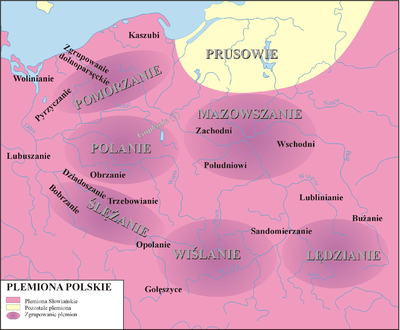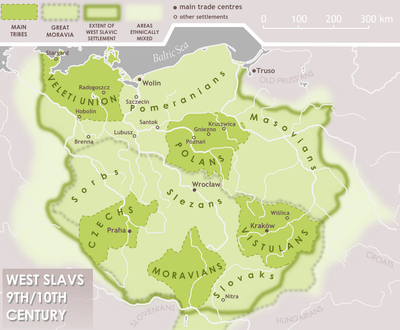Polish tribes

Polish tribes - a term used sometimes to describe the tribes of West Slavs that lived in the territories that became Polish from around the mid-7th century to the creation of Polish state by the Piast dynasty. The territory they lived on became a part of the first Polish state created by duke Mieszko I and expanded at the end of the 10th century, enlarged further by king Bolesław I at the beginning of the 11th century.
In about 850 AD a list of peoples was written down by the Bavarian Geographer. Absent on the list are Polans, Pomeranians and Masovians, who were mentioned later by Nestor the Chronicler in his Primary Chronicle (11th/12th century).
The most important Polish tribes are Polans, Masovians, Vistulans, Silesians and Pomeranians.[1] These five tribes "shared fundamentally common culture and language and were considerably more closely related to one another than were the Germanic tribes."[2]
Name
The name "Poland" is derived from the most important tribe - the Polans. Their name, in turn, derives from the word pole - field. It was also used for the eastern Polans that lived in the region of the Dnieper River.
Organization
The tribes were organized on the basis of kinship groups. A tribe's territory was divided into opoles, which constituted a group of neighboring settlements.
Most members of a particular tribe were yeoman peasants, although a small group of aristocrats (nobiles or potentiores) was usually present.
List of Polish tribes

The following is the list of Polish tribes that inhabited the lands of Poland in the early Middle Ages, at the beginning of the Polish state. They shared fundamentally common culture and language and together they formed what is now Polish ethnicity and the culture of Poland. This process is called ethnic consolidation in which several ethnic communities of kindred origin and cognate languages, merge into a single one.[3]
- Polans
- Pomeranians
- Pyrzyczanie
- Wolinianie
- Goplans
- Lędzianie (Lendians)
- Masovians
- Vistulans
- Silesian tribes, usually treated as part of Polish tribes[4] although two tribes among them are sometimes considered as Czech (Moravian) tribes.[5]
See also
References
- ↑ Raymond Breton, National Survival in Dependent Societies: Social Change in Canada and Poland, McGill-Queen's Press - MQUP, 1990, p. 106,ISBN 0-88629-127-5 Google Books
- ↑ John Blacking, Anna Czekanowska, Polish Folk Music: Slavonic Heritage - Polish Tradition - Contemporary Trends, Cambridge University Press, 2006, p. 3, ISBN 0-521-02797-7 Google Books
- ↑ Regina E. Holloman, Serghei A. Arutiunov, Perspectives on Ethnicity, Walter de Gruyter 1978, p. 391, ISBN 311080770X, 9783110807707 Google Books
- ↑ Jerzy Strzelczyk [in:] The New Cambridge Medieval History, Cambridge University Press, 1999, p. 521-522 ISBN 0-521-36447-7 Google Books; Robert Machray, The Problem of Upper Silesia, G. Allen & Unwin ltd. 1945, p. 13 Google Books; Paul Wagret, Helga S. B. Harrison, Poland, Nagel, 1964, p. 231. Google Books
- ↑ "Czeski Śląsk" - Montes Tarnovicensis, 05/2008